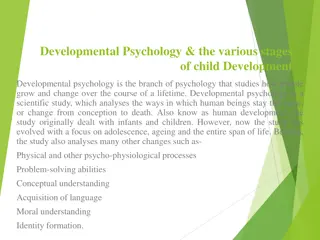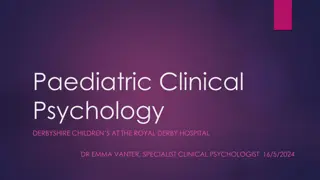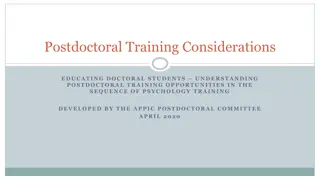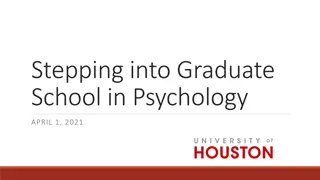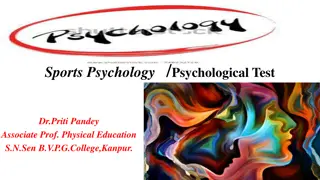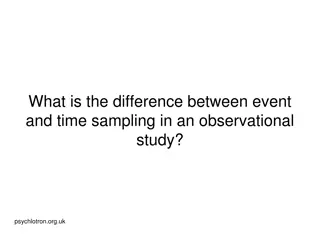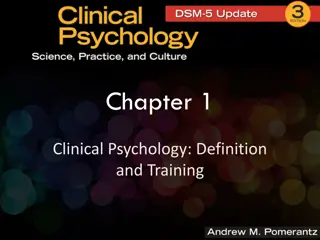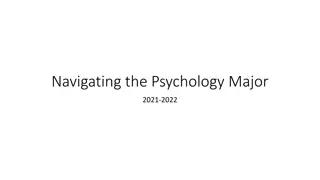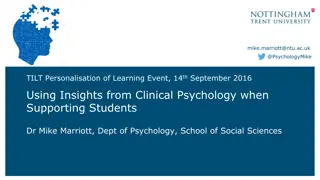Training Models in Clinical Psychology: A Comprehensive Overview
Clinical psychology training models such as the Scientist-Practitioner Model have evolved over the years to integrate science and practical expertise. The Scientist-Practitioner Model, originating in 1949, emphasizes the fusion of scientific knowledge and clinical application. It faced criticism for prioritizing research over practical skills initially. However, it remains a popular approach in training clinical psychologists.
- Clinical psychology
- Training models
- Scientist-Practitioner Model
- Psychologist
- Psychological practice
Download Presentation

Please find below an Image/Link to download the presentation.
The content on the website is provided AS IS for your information and personal use only. It may not be sold, licensed, or shared on other websites without obtaining consent from the author. Download presentation by click this link. If you encounter any issues during the download, it is possible that the publisher has removed the file from their server.
E N D
Presentation Transcript
Current Issues in Clinical Psychology Assist. Prof. Dr. Orkun Ayd n Head of Department Program Coordinator Office: B.F.2.23 Office phone: 305 (Internal) E-mail: oaydin@ius.edu.ba Instagram: orkunaydinmd
Questions What are the advantages and disadvantages of various models of training for clinical psychologists? (This week) What obstacles face clinical psychologists who specialize in private practice? (Next week) What are the advantages and disadvantages of obtaining prescription privileges? (Next week) What technological innovations are likely to influence the practice of clinical psychology? (Next week)
What are the best training models for a clinical psychologist? MODELS OF TRAINING IN CLINICAL PSYCHOLOGY 1. The Scientist-Practitioner Model 2. Clinical Scientist Model 3. The Doctor of Psychology (Psy.D.) Degree 4. Professional Schools 5. Combined Professional-Scientific Training
The Scientist-Practitioner Model First established in 1949. This model represents an attempt to marry science and clinical practice. It remains the most popular training model for clinical psychologists even to this day.
The Scientist-Practitioner Model It is useful to remember that clinical psychology began in universities as a branch of scientific psychology. It arose within the structure of colleges of arts and sciences, where teaching, research, and other scholarly efforts were prominent. During this era, training in the practice of clinical psychology did not receive priority.
The Scientist-Practitioner Model Clinical psychology professors carried out research and they published their work. However, their critics (often graduate students or clinicians in the field) complained that much of the research was trivial. Some students complained that they were learning too much about statistics, theories of conditioning, or principles of physiological psychology and too little about psychotherapy and diagnostic testing.
The Scientist-Practitioner Model The Boulder model, also known as the scientist-practitioner model, saw a profession comprised of skilled practitioners who could produce their own research as well as consume the research of others. The goal was to create a profession different from any that had gone before.
The psychological clinician would practice with skill and sensitivity contribute to the body of clinical knowledge by understanding how to translate experience into testable hypotheses and how to test those hypotheses.
The Scientist-Practitioner Model It was intended that the scientist-practitioner model would help students of clinical psychology think like a scientist in whatever activities they engaged in. As a clinician, they would evaluate their clients progress scientifically and select treatments that were based on empirical evidence.
Is it that hard to conduct research? Although it is true that practicing clinicians do not do much in the way of research, this may be largely because their work settings do not permit it. The former can only produce solid, meaningful research if they keep their clinical sensitivity and skills honed by continuing to see patients.
Take home advice: The practitioners must not forsake their research training, and neither must researchers ignore their clinical foundation.
The debate continues; The mood of professionalism seems to grow every year. Increasingly, clinical psychologists are split into two groups: 1. those interested primarily in clinical practice and 2. those interested primarily in research. Although many believe that the scientist-practitioner model has served us well and successfully, others conclude that it is a poor educational model that deserves the wrath of its critics.
The Doctor of Psychology (Psy.D.) Degree The special characteristics of these degrees are an emphasis on the development of clinical skills and a relative de-emphasis on research competence. A master s thesis is not required, and the dissertation is usually a report on a Professional subject rather than an original research contribution. The first of these programs was developed at the University of Illinois in 1968.
Psy. D. Vs Ph.D. 1. Psy.D. Programs are not substantially different from Ph.D. Programs during the first two years of training. 2. The real divergence begins with the third year. 3. At that point, increasing experience in therapeutic practice and assessment becomes the rule. 4. The fourth year continues the clinical emphasis with a series of internship assignments.
Practice rocks More recently, Psy.D. Programs have moved toward compressing formal coursework into the first year and expanding clinical experience by requirements such as 5-year practica. Currently, there are more than 60 accredited doctoral programs in clinical psychology that offer the Psy.D. More Psy.D degrees are awarded each year in clinical psychology (over 1,300) than are Ph.D. degrees.
Although the average number of applications for each type of program are similar, Psy.D programs: accept more applicants each year (Mdn 47 vs. 8), enroll more students each year (Mdn 28 vs. 6), have more students in the program (Mdn 130 vs. 39), and award more doctoral degrees each year (1,350 vs. 1,222) than do Ph.D. programs in clinical psychology.
Professional Schools Although the Psy.D. model represents a clear break with tradition, an even more radical innovation is the development of professional schools. Many of these schools have no affiliation with universities; they are autonomous, with their own financial and organizational framework. Often referred to as freestanding or for-profit schools, most offer the Psy.D.
Professional Schools Most schools emphasize clinical functions and generally have little or no research training in the traditional sense. Faculty are chiefly clinical in orientation. The first such freestanding professional school was the California School of Professional Psychology (Dorken, 1975), founded by the California State Psychological Association.
Current state In 1987, there were 45 professional schools in operation, awarding several hundred of the 3,000 yearly clinical doctorates (Strickland, 1988). Today, there are about twice as many professional schools, and each year over 60% of the doctorates in clinical psychology are awarded by professional schools (1,574 vs. 919; Kohut & Wicherski, 2010)!
Professional Schools The proportion of doctorates in clinical psychology awarded by professional schools has increased dramatically over time. These programs tend to admit far more students (sometimes over 100!) than traditional university-based scientist-practitioner programs.
Professional Schools How many professional schools ultimately will survive is still uncertain. One of their greatest problems is stability of funding. Many such institutions must depend on tuition as their main source of funds, which may not generate enough money to make them financially secure.
Disadvantages of Professional schools In contrast, the majority of university-based Ph.D. Programs waive tuition completely for graduate students (Free). Professional schools also often depend heavily on part-time faculty members whose major employment is elsewhere. As one consequence, it sometimes is difficult for students to have the frequent and sustained contacts with their professors that are so vital to a satisfactory educational experience.
Advantages of Professional Schools Some professional schools are fully accredited by the APA, they are the exception rather than the rule. This is a major handicap that such schools will have to overcome if their graduates are to find professional acceptance everywhere. Despite these concerns, recent conferences on training seem to suggest that both Ph.D. and Psy.D. programs have found secure niches and are here to stay.
Clinical Scientist Model Over the past several decades, empirically oriented clinical psychologists concerned that clinical psychology, as currently practiced, is not well grounded in science. According to this view, many of the methods that practitioners employ in their treatment have not been demonstrated to be effective in controlled clinical studies.
Why do we need a Clinical Scientist Model? 1) Empirical studies of these techniques have not been completed 2) Researches that have been completed does not support continued use of the technique. 3) The use of assessment techniques that have not been shown to be reliable and valid and to lead to positive treatment outcome has been called into question. ****These concerns led to a proposed new model of training for clinical psychologists, the clinical scientist model.
Scientific clinical psychology is the only legitimate and acceptable form of clinical psychology (from their Manifest) Psychological services should require four minimal criteria: a. The exact nature of the service must be described clearly. b. The claimed benefits of the service must be stated explicitly. c. These claimed benefits must be validated scientifically. d. Possible negative side effects that outweigh any benefits must be ruled out empirically
Clinical Scientist Model One outgrowth of this model of training is the Academy of Psychological Clinical Science, formed in 1995. The academy consists of graduate programs and internships that are committed to training in empirical methods of research and to the integration of this training with clinical training.
The academy is affiliated with the Association for Psychological Science (APS), and it is comprised of over 60 member programs (including both doctoral and internship programs).
Clinical Scientist Model Essentially, a network of graduate programs and internships that adhere to the clinical science model has developed. These programs share ideas, resources, and training innovations. Further, they collaborate on projects aimed at increasing grant funding from governmental agencies, and increasing the visibility of clinical science programs in undergraduate education.
Clinical Scientist Model Most recently, this organization has been a leader in setting up a new accreditation system that will brand clinical science training by accrediting programs. More programs have embraced this model of training for clinical psychologists. Further, the addition of internships into the Academy has provided the opportunity for a continuum of clinical science training in a variety of settings (e.g., classroom, research laboratory, and clinical settings).
Combined Professional-Scientific Training Programs A final alternative training model that we will discuss briefly involves a combined specialty in counseling, clinical, and school psychology. This training model assumes that (a) these specialties share a number of core areas of knowledge and (b) the actual practices of psychologists who graduate from each of these specialties are quite similar.
Combined Professional-Scientific Training Programs The curriculum in these combined training programs focuses on core areas within psychology and exposes students to each subspecialty of counseling, clinical, and school psychology. The combined training model emphasizes breadth rather than depth of psychological knowledge. However, this feature can also be seen as a potential weakness of the model.
Combined Professional-Scientific Training Programs Graduates from this type of training program may not develop a specific subspecialty or area of expertise. Model is better suited for the practitioner than for the academician or clinical scientist. There are 8 APA-accredited programs, three of which offer a Psy.D. degree
Graduate Programs: Past and Future In many ways, the changes in graduate training over the past 60 years have mirrored the marketplace for clinical psychologists. Starting in the mid-1960s, a shift occurred from university-based academic jobs to jobs in private practice. Not surprisingly, complaints about the limitations of the scientist practitioner model of training surfaced soon thereafter.
Summary According to the critics, training in clinical skills was deficient, and faculty members were oblivious to the training needs of future practitioners. Out of the Vail Training Conference in 1973 came an explicit endorsement of alternative training models to meet the needs of the future practitioner.
Summary The alternative Psy.D. degree and professional school model of training can be traced to the positions adopted by those attending this conference. Clearly, these alternative training programs became increasingly influential, as indicated by the number of new doctorates they graduate.
However, several and success of the various training models discussed here. several trends trends may may affect affect the viability First, for some time, many have argued that there is an oversupply of practice-oriented psychologists given market demands. If true, this may ultimately affect the number of students entering and finishing graduate programs in clinical psychology. In recent years, there have been many more applicants for internship positions than slots available.
New trends The managed health care (insurance companies) revolution will likely affect the demand for clinical psychologists in the future as well as the curriculum in training programs. More emphasis will be placed on coursework involving empirically supported brief psychological interventions and focal assessment (time limited psychodynamic psychotherapy). Training programs that do not employ faculty with expertise in these areas may produce graduates without the requisite skills to compete in the marketplace.
Possible Consequences Finally, there may be an undersupply of academic and research- oriented clinical psychologists. If true, scientist-practitioner and clinical scientist programs may be in a better position to meet this need. Research-oriented clinical psychologists will be better able to develop and evaluate effective treatments for psychological problems, and provide supervision for both research and treatments.
What is the milestone? All of these roles are highly valued in the current behavioral health care market in which 1) effectiveness, 2) accountability, 3) cost-effectivity are emphasized
Notes Substantial numbers of clinical psychologists work in private practice settings. Increasing trend, mirroring the aspirations of many students in clinical training. For some clinical psychology graduate students, their goal is essentially to open an office and be single. (a model that does create certain hazards?)
Emphasis-De-emphasis The American Medical Association is often perceived not as the public s guardian, but as the protector of the rights and advantages of the physician. What alarms many psychologists is that clinical psychology seems to be moving in the same direction. The emphasis on restrictive legislation, diplomas, and political activism and the de-emphasis on research strike.
Training clinicians for private practice is an economical response to the public s mental health needs????? The beginning: honest and dedicated attempt to improve training, provide continuing professional growth, protect the public, and improve the common good. The end: a selfish posture of vested interest. Obviously, private practice is not the only place such trends can develop, but the danger exists.
Private practice survives Nevertheless, private practice with all its concern about insurance coverage, Professional rivalry with psychiatry, and statutory regulation seems here to stay. Traditional fee-for-service private practice is a thing of the past managed health care now dominates the scene.









